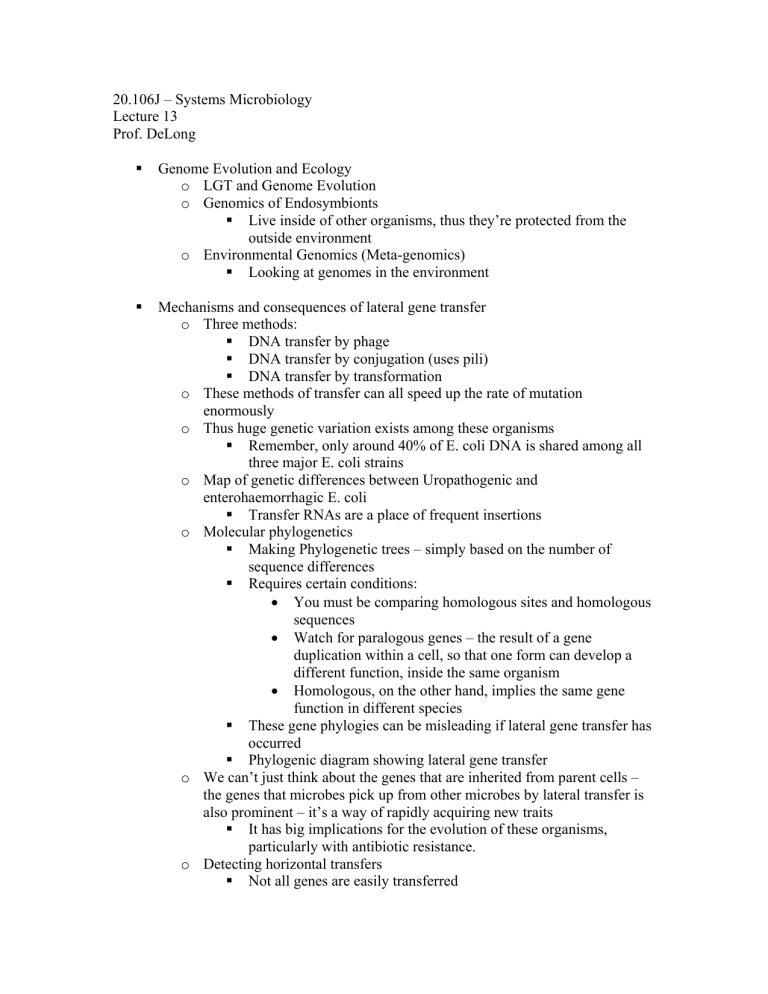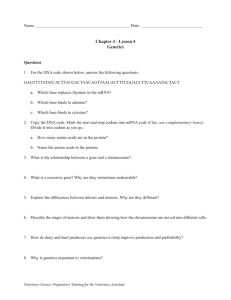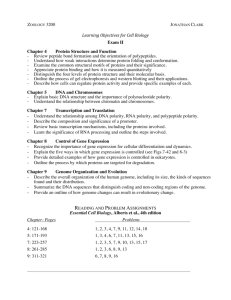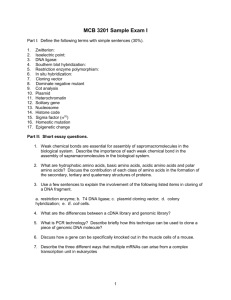20.106J – Systems Microbiology Lecture 13 Prof. DeLong

20.106J – Systems Microbiology
Lecture 13
Prof. DeLong
Genome Evolution and Ecology o LGT and Genome Evolution o Genomics of Endosymbionts
Live inside of other organisms, thus they’re protected from the outside environment o Environmental Genomics (Meta-genomics)
Looking at genomes in the environment
Mechanisms and consequences of lateral gene transfer o Three methods:
DNA transfer by phage
DNA transfer by conjugation (uses pili)
DNA transfer by transformation o These methods of transfer can all speed up the rate of mutation enormously o Thus huge genetic variation exists among these organisms
Remember, only around 40% of E. coli DNA is shared among all three major E. coli strains o Map of genetic differences between Uropathogenic and enterohaemorrhagic E. coli
Transfer RNAs are a place of frequent insertions o Molecular phylogenetics
Making Phylogenetic trees – simply based on the number of sequence differences
Requires certain conditions:
•
You must be comparing homologous sites and homologous sequences
•
Watch for paralogous genes – the result of a gene duplication within a cell, so that one form can develop a different function, inside the same organism
•
Homologous, on the other hand, implies the same gene function in different species
These gene phylogies can be misleading if lateral gene transfer has occurred
Phylogenic diagram showing lateral gene transfer o We can’t just think about the genes that are inherited from parent cells – the genes that microbes pick up from other microbes by lateral transfer is also prominent – it’s a way of rapidly acquiring new traits
It has big implications for the evolution of these organisms, particularly with antibiotic resistance. o Detecting horizontal transfers
Not all genes are easily transferred
For example, ribosomal DNA is too complex a machinery to move around easily
•
Thus you can use ribosomal DNA to map a cell’s genetic descent, ignoring lateral transfers.
You can also detect later transfer by comparing operons – conservation of gene order
Anomalous DNA composition is also relevant – if there’s a block of much higher AT or GC composition, for example
Genome Evolution in the context of natural history and the organism. We’ll focus on one system that is particularly well understood – the aphid. o They poke holes in plants and eat the flow o This food is very nutritionally poor mostly carbohydrates – no amino acids, very little nitrogen. o The only reason they’re able to survive this way is that they have bacterial endosymbionts that produce amino acids for them. o Essential amino acids – there are ten amino acids that we have to get in our diet, because we can’t produce them ourselves o Back in the 1900s, with light microscropy, scientists could see that many insect cells contain packaged organelles called bacteriomes that are just stuffed full of bacteria – obligate endosymbionts o These endosymbionts were providing the insects with amino acids o A map of co-evolution: symbiont phylogeny mirrors host phylogeny
This doesn’t show time though
However, there’s a fossil record for aphids, showing that it looks like aphids arose together with their sybionts around 150 million years ago o You can extract the DNA of these symbionts and assemble the whole genome
The genome is a lot smaller, since they don’t have to live out in the environment
Somewhere around 400 kilobase pairs o These Buchnera endosymbionts are derived from E. coli
We can reconstruct a common ancestor, which would have looked very much like E. coli
The gene loss must have happened very rapidly
This process is described in a paper by Siv Andersson
After 70 million years, there are no chromosomal rearrangements or gene acquisitions
But considerable sequence divergence does occur
They’re changing around 2000 times faster
Accumulation of pseudo-genes restrict the diet of the aphids
The evolutionary dynamic is very different – there isn’t any rearrangement
Many fewer non-synonymous substitutions occur
Also very few repeats
This sort of genome reduction can get really extreme, as long as the host relationship is stable enough
The symbiont has lost the ability to regulate its own gene control – it doesn’t have the mechanisms that free-living bugs like E. coli have, so it can’t make more or less amino acids depending on the diet that the aphid is on
Another system: Baumannia and Sulcia in the Glassy-winged Shapshooter o The genomes are pretty similar to Buchnera o You have to think of the insect like an ecosystem o One wonders: how much are there similar things going on in out own systems? o For example, it looks like human genetics determines which bacteria live in our stomach and intestines, which influences obesity.








